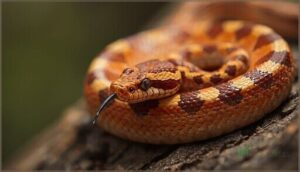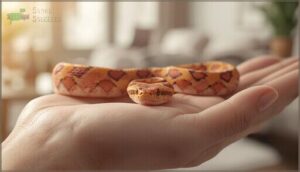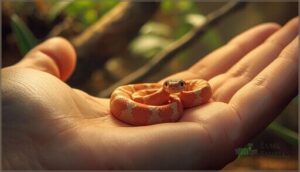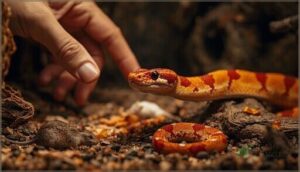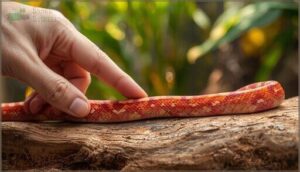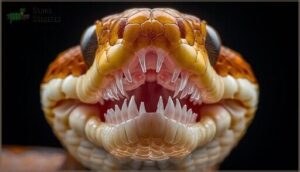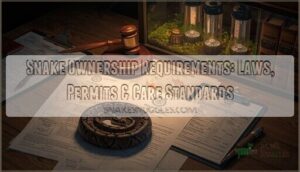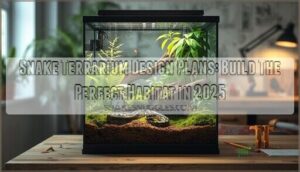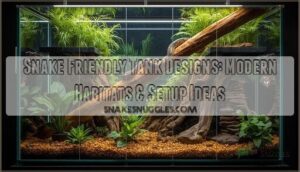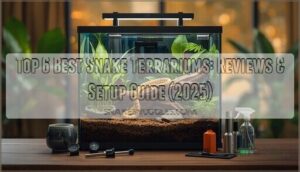This site is supported by our readers. We may earn a commission, at no cost to you, if you purchase through links.
You won’t find corn snakes lunging at fingers during routine handling sessions. These docile constrictors bite less than 1% of the time when properly cared for, making them one of the most tolerant pet snake species available. Most captive-bred individuals go their entire lives without nipping their owners.
The rare bites that do occur usually happen for predictable reasons: a snake mistakes your hand for food during feeding time, or it feels cornered and defenseless. Understanding what triggers these infrequent defensive reactions helps you avoid them entirely.
Recognizing your snake’s stress signals and adjusting your handling approach transforms bite prevention from guesswork into straightforward routine care.
Table Of Contents
- Key Takeaways
- Do Corn Snakes Bite Often?
- Why Do Corn Snakes Bite?
- Are Corn Snake Bites Dangerous?
- What Does a Corn Snake Bite Feel Like?
- How Often Do Baby Corn Snakes Bite?
- Factors That Increase Bite Risk
- How to Prevent Corn Snake Bites
- What to Do if Bitten by a Corn Snake
- Corn Snake Teeth and Biting Anatomy
- Myths and Facts About Corn Snake Bites
- Frequently Asked Questions (FAQs)
- Can you be bitten by a corn snake?
- Why does my corn snake bite me?
- How many types of corn snakes are there?
- Are corn snakes poisonous?
- What happens if a corn snake bites a dog?
- Do corn snakes strike at you?
- What Should I Do if I’m Bitten by a Corn Snake?
- Are Corn Snake Bites Harmful?
- Are Baby Corn Snakes More Likely to Bite?
- How Do I Know if My Corn Snake is Stressed?
- Conclusion
Key Takeaways
- Corn snakes bite less than 1% of the time in captivity, with most captive-bred individuals never biting their owners throughout their entire lives.
- Bites occur primarily from feeding mistakes when snakes confuse hands for prey or from defensive reactions when cornered, not from aggression or malicious intent.
- Baby corn snakes bite more frequently than adults due to natural defensiveness, but this behavior decreases significantly within the first six months through consistent, gentle handling.
- Corn snake bites are harmless—they lack venom glands entirely and cause only minor puncture wounds comparable to pinpricks that heal within 2-3 days with basic cleaning.
Do Corn Snakes Bite Often?
Corn snakes rarely bite, especially when you compare them to other pet snakes. Their docile nature makes them one of the safest reptiles for beginners and experienced handlers alike.
Let’s look at how often these bites actually happen and what situations might trigger them.
Typical Biting Frequency
Corn snake bite frequency in captivity is remarkably low. Well-socialized, captive-bred individuals bite less than 1% of the time during regular handling. Most owners report their snakes seldom or never bite.
When bites do occur, they’re usually minor scratches that heal quickly without medical intervention—making bite frequency data among the most reassuring statistics for prospective keepers.
Understanding the role of nonvenomous snakes can also provide insight into their behavior and safety.
Biting Behavior in Captivity Vs. Wild
You’ll notice captive-bred corn snakes bite far less frequently than their wild counterparts—and the reasons become clear when you compare their worlds. Habitat effects shape these differences dramatically:
- Captive stress levels drop with consistent handling and socialization
- Wild encounters involve predators, triggering defensive mechanisms constantly
- Snake socialization in captivity reduces perceived threats during human interaction
- Environmental influences like stable temperatures minimize stress-induced biting
- Corn snake biting likelihood decreases as familiarity with handlers increases
Handling corn snakes safely becomes easier when they’re raised in controlled settings. Corn snake behavior shifts from defensive to tolerant through regular, gentle contact. Understanding corn snake bite prevention starts with recognizing how environmental influences and early socialization create calmer, more predictable pets. By following proper stress reduction techniques, owners can minimize the risk of bites and create a safe environment for their pets.
Biting Incidents Among Pet Owners
When you bring home a corn snake, actual biting incidents are refreshingly uncommon. Most pet owners report fewer than 5% experience serious bite episodes—and those usually trace back to handling techniques or environmental factors during feeding time.
Your owner experience matters here: novice handlers misread snake behavior more often, while seasoned keepers recognize stress signals that prevent most corn snake bites entirely.
Why Do Corn Snakes Bite?
Corn snakes don’t bite out of aggression or spite—they bite because something in their environment triggers a survival response. Understanding these triggers helps you avoid most bites before they happen.
Corn snakes bite only when their environment triggers a survival response, not from aggression or spite
Let’s look at the three main reasons corn snakes strike.
Mistaken Identity During Feeding
Sometimes your corn snake’s hunger instinct can work against you. During feeding, nonvenomous snakes like corn snakes may bite when they mistake your fingers for prey, especially if you’re handling food or if rodent scent lingers on your hands.
This prey mistaken response isn’t aggression—it’s pure instinct.
Using feeding tongs and proper feeding techniques dramatically reduces these handling risks while improving feeding safety.
Defensive Reactions
When you corner or startle your corn snake, its bite reflex kicks in as a last-resort threat response. Defensive postures—like that telltale S-shaped curve, hissing, or tail vibration—are stress signals warning you to back off.
These defensive mechanisms aren’t aggression; they’re survival instincts. Recognizing these behaviors helps you avoid bites entirely, keeping both you and your snake safer during handling.
Stress and Environmental Factors
Environmental stress from suboptimal habitat conditions—like inadequate thermal gradients, wrong humidity levels, or missing hideouts—triggers defensive behavior in your corn snake. When temperatures stray from the ideal 85°F warm end or humidity dips below 40%, stress signals emerge: rapid tongue flicking, hissing, and increased biting.
Proper stress management through consistent environmental stressors control keeps your snake calm and reduces bite incidents markedly.
Are Corn Snake Bites Dangerous?
The good news is that corn snake bites pose minimal risk to humans. These snakes lack venom and have small teeth that rarely cause significant injury.
Let’s break down the real facts about toxicity, pain levels, and what can actually go wrong.
Venom and Toxicity Myths
One of the most persistent venom myths about corn snakes is that they’re somehow venomous. They’re not. Here’s what you need to know about toxicity facts:
- Corn snakes completely lack venom glands found in venomous species
- Their saliva contains zero toxic proteins or venom-producing compounds
- Snake bite risks are limited to minor puncture wounds, not envenomation
- No antivenin exists for corn snakes because none is needed
- Toxicity studies confirm these nonvenomous constrictors pose no poisoning threat
Pain Level and Injury Severity
If you’re worried about the pain, don’t be. Most corn snake bite pain registers as barely a pinch—think less painful than a paper cut. The bite wound care is straightforward: you’ll see tiny puncture marks, maybe a drop of blood, but skin damage is minimal.
These snake bite symptoms resolve quickly, usually within days. Pain management? You won’t need it. The pain scale rating is genuinely mild, and wound healing happens fast without complications.
Infection Risks
Bacterial infections from corn snake bites remain uncommon, though roughly 27% of snakebites develop some infection risk. You’ll recognize infection symptoms like swelling, warmth, or pus discharge.
Proper snake bite wound care matters most: wash hands before touching the wound, clean the bite area thoroughly, and apply first aid basics.
Most bite complications resolve without antibiotic use, but monitor the wound for several days.
What Does a Corn Snake Bite Feel Like?
If you’ve ever wondered what it’s like to get nipped by a corn snake, the good news is that it’s nowhere near as bad as you might imagine. Most people describe the sensation as surprisingly mild—more startling than painful.
Let’s break down what you can actually expect regarding pain, appearance, and any potential damage to your skin.
Pain Comparison to Other Injuries
A corn snake bite ranks low on the pain scale—most people compare it to a light pinch or pinprick. Pain thresholds vary, but the injury severity is minimal, usually less than a cat scratch.
The wound heals quickly with basic care. Snake bite pain is fleeting, and bite reactions are mild. Effective pain management? Just clean the area.
Skin damage stays superficial, making these bites barely memorable.
Typical Bite Appearance
Beyond the sensation itself, you’ll want to know what you’re actually looking at. Corn snake bites leave distinctive marks that help with bite wound care and snake bite safety.
Here’s what to expect:
- Multiple tiny puncture marks from 20-30 small, recurved teeth—not the paired fang marks of venomous species
- Minimal bleeding that stops within seconds, making wound assessment straightforward
- Slight redness around snake tooth marks without swelling or bruising
- Bite diameter under one centimeter, resembling minor bite symptoms like thorn pricks
- Quick healing within 2-3 days with proper puncture wound healing protocols
The absence of deep tissue damage or bite site infection risk makes corn snake bites manageable. Clean the wound promptly, and you’ll barely notice it happened—snake bite pain fades fast.
Bleeding and Skin Damage
You’ve seen the marks—now let’s talk about what actually happens beneath the surface. Bleeding from corn snake bites is minimal. Their backward-angled teeth create shallow puncture wounds that stop bleeding within minutes as blood clotting kicks in naturally.
| Damage Type | Severity | Healing Time |
|---|---|---|
| Puncture wounds | Superficial pinpricks | 2-3 days |
| Skin tears | Minor surface breaks | 3-5 days |
| Bleeding | Drops, stops quickly | Under 5 minutes |
| Skin damage | Outermost layer only | 48-72 hours |
| Infection risk | Low with proper cleaning | N/A |
Proper wound healing requires basic infection control—wash with soap and water, apply antiseptic. That’s it. No deep tissue injury means your skin repairs itself fast without complications.
How Often Do Baby Corn Snakes Bite?
Baby corn snakes bite more often than adults, but it’s not because they’re mean—they’re just skittish and still learning to trust you. Young snakes tend to be more defensive since everything feels like a threat when you’re small and vulnerable.
Understanding how juvenile behavior differs from adult snakes and how to handle them properly will help you avoid those nervous little nips.
Juvenile Vs. Adult Behavior
Young corn snakes are naturally more defensive than adults. Baby corn snakes bite several times more often during their first few months as they adjust to handling. Understanding these behavioral differences and maturity stages helps with corn snake bite prevention:
- Hatchlings strike frequently – Juveniles measuring 8-12 inches often mistake your hand for a threat
- Growth patterns matter – By 6 months (20-30 inches), biting decreases with proper socialization techniques
- Adults rarely bite – Mature snakes (4-6 feet) trust handlers through environmental adaptation
Handling corn snakes improves with age and experience.
Handling Young Corn Snakes
After bringing your baby corn snake home, let it settle for 1-2 weeks before handling. This acclimation period reduces stress and bite prevention becomes easier.
Start with brief 10-15 minute sessions a few times weekly, using proper support with both hands. Move slowly and avoid handling 24-48 hours after feeding.
These snake handling techniques help baby corn snakes adjust to you without triggering corn snake bites.
Factors That Increase Bite Risk
While corn snakes are naturally docile, certain situations can make them more likely to bite. Understanding these triggers helps you avoid startling or stressing your snake during vulnerable moments.
Let’s look at the most common factors that increase your chances of getting nipped.
Improper Handling Techniques
Handling errors dramatically increase your bite risk. Sudden grabs from above trigger predatory defense instincts, while poor snake restraint without full-body support creates anxiety.
You’ll reduce defensive biting by 30% using proper handling techniques: approach from the side, use gentle touch, employ both hands for support techniques, and implement calming methods through slow movements.
Regular handling safety practices build trust, while improper handling invites trouble—especially during sensitive periods when your corn snake needs extra consideration.
Hunger and Feeding Times
Frequently, hunger triggers mistaken identity bites—your corn snake confuses your hand with food. Maintaining proper feeding schedules prevents this confusion and reduces bite incidents markedly.
Follow these feeding techniques for effective bite prevention:
- Feed hatchlings every 5-7 days to satisfy hunger cues
- Offer juveniles rodents every 7-10 days as prey
- Space adult feedings 10-14 days apart
- Match food sizes to 1-1.5 times body width
- Avoid handling 48 hours before snake feeding habits occur
Consistent corn snake feeding routines minimize food aggression and keep your snake calm during diet transitions.
Shedding and Stressful Periods
During shedding, your corn snake’s vision becomes impaired—especially in the “blue phase“—making it more likely to bite defensively. This vulnerable period increases irritability as the snake expends significant energy molting.
Avoid handling during shedding and watch for stress signals like excessive hiding or hissing.
Maintain stable humidity (50-70%) and provide rough surfaces to help natural shedding, reducing defensive behavior and post-shedding sensitivity.
How to Prevent Corn Snake Bites
Preventing bites comes down to understanding your corn snake’s needs and respecting its boundaries. A few simple practices can dramatically reduce the chances of a defensive reaction.
Let’s look at the key strategies that keep both you and your snake comfortable during handling and daily care.
Safe Handling Practices
You can minimize bite risk by mastering gentle handling techniques. Support your corn snake’s entire body with both hands to prevent stress.
Prepare the enclosure with stable temperatures between 75°F and 85°F, plus hiding spots. Avoid handling within 24-48 hours post-feeding or during shedding—these special conditions make snakes irritable.
Limit sessions to 10-30 minutes several times weekly for long-term maintenance and trust-building.
Recognizing Stress Signals
Your corn snake’s body language speaks volumes if you know what to watch for. Recognizing stress signals early prevents bites and keeps both of you safe during handling.
Watch for these defensive behavior indicators:
- Rapid tongue flicks – excessive sampling of air signals heightened anxiety
- Hissing and striking – direct warnings of acute stress
- Excessive hiding – prolonged retreat indicates environmental discomfort
- Restlessness signs – constant pacing or escape attempts reveal agitation
- Head thrashing – immediate physical display of distress
Understanding snake behavior helps you respond before stress escalates.
Maintaining a Comfortable Habitat
A well-maintained snake enclosure reduces stress and prevents defensive bites. Temperature gradients between 70-85°F allow proper thermoregulation, while substrate selection like soil-based mixes encourages natural burrowing.
Environmental enrichment through climbing branches and hiding spots keeps your snake mentally stimulated.
Regular habitat maintenance, including proper humidity levels and spacious enclosure size, creates the stability your corn snake needs to feel secure during snake handling sessions.
What to Do if Bitten by a Corn Snake
Getting bitten by a corn snake isn’t a crisis, but you’ll want to handle it properly to avoid any complications. The good news is that treatment is straightforward and doesn’t require panic or a trip to the emergency room in most cases.
Here’s what you need to do right after a bite, how to watch for problems, and when professional help might be necessary.
Immediate First Aid Steps
If a corn snake bite happens, staying calm prevents escalation. Assess severity by checking for bleeding or unusual swelling. Clean the wound thoroughly with lukewarm water and mild soap, then apply an antiseptic like hydrogen peroxide. Cover the bite with a sterile, breathable dressing to protect against dirt and irritation.
- Gently encourage the snake to release if still attached—never force its jaw open
- Rinse debris away immediately to reduce bacterial contamination
- Raise the affected area to minimize swelling and discomfort
Monitoring for Infection
After cleaning your wound, check it daily for the next week. Infection signs include redness spreading from the bite, warmth, swelling, or yellow discharge. These symptoms usually appear within 24-48 hours. Photograph the area to track changes.
Apply antiseptic treatments and keep the wound covered with sterile dressings. Proper wound care prevents bacterial risks and aids healing processes—most bites heal completely within two weeks.
When to Seek Medical Advice
Most corn snake bites heal without medical evaluation, but watch for infection signs like fever, pus, or spreading redness beyond 24 hours. Seek immediate emergency response if you experience allergic reactions—difficulty breathing or severe swelling.
Snake bite treatment includes tetanus boosters if you’re overdue. Dealing with snake bites means knowing when home wound care isn’t enough, especially with uncontrolled bleeding or worsening pain despite proper snake bite risks management.
Corn Snake Teeth and Biting Anatomy
Understanding the physical makeup of a corn snake’s mouth helps explain why their bites are so mild. These snakes don’t have the anatomy you’d find in venomous species, which makes them fundamentally different regarding bite risks.
Let’s look at the specific features that define how corn snakes bite.
Teeth Structure and Function
Understanding corn snake teeth anatomy helps you realize why their bites rarely cause harm. Their jaw mechanics include several rows of small, backward-angled teeth designed for gripping prey during constriction methods—not for defense. Here’s what makes their dental structure unique:
- Multiple tooth rows on the upper and lower jaw
- Backward-curving design that locks prey in place
- Fragile, brittle teeth that break easily during feeding
- Continuous dental regeneration replaces lost teeth rapidly
These snake teeth lack the sturdy structure of fangs, focusing instead on mechanical prey handling rather than causing injury.
Lack of Fangs or Venom Glands
Unlike their venomous relatives, corn snakes lack the specialized anatomy needed for venom delivery. You won’t find hollow fangs or venom glands in these nonvenomous constrictors. Snake evolution took them down a different path—they rely on constriction mechanisms instead of toxins to subdue prey.
| Feature | Venomous Snakes | Corn Snakes |
|---|---|---|
| Fang Anatomy | Hollow or grooved fangs | Solid, small teeth |
| Venom Gland Structure | Specialized toxin-producing glands | Completely absent |
| Prey Capture Method | Venom injection | Constricting coils |
| Bite Risk to Humans | Potentially dangerous | Harmless scratches |
| Medical Treatment Needed | Antivenom may be required | Basic wound care only |
This fundamental difference makes corn snake bites mechanically minor—just punctures from tiny backward-angled teeth.
Myths and Facts About Corn Snake Bites
You’ve probably heard some wild stories about corn snakes being aggressive biters, but most of these claims don’t hold up under scrutiny. The truth is that corn snakes are among the most docile pet snakes you can own, and understanding the real facts helps separate fear from reality.
Let’s clear up the most common misconceptions and see how corn snakes actually compare to other popular pet species.
Aggression Misconceptions
Many people wrongly believe corn snakes are aggressive biters, but these reptiles rank among the most docile snake species you can own.
- Corn snakes usually flee rather than attack when threatened
- Most bites stem from defensive reactions during improper handling, not aggression
- Feeding-related mistakes occur when your snake confuses your hand for prey
- Defensive behavior increases during shedding or environmental changes
- Pet owners commonly report zero bites throughout years of ownership
Comparing Corn Snakes to Other Pet Snakes
When comparing corn snakes to other popular pet snakes, you’ll find they’re consistently among the calmest options. Ball pythons match their gentle temperament, while king snakes bite more frequently despite being non-venomous. Garter snakes carry mild venom that’s harmless to humans, and boa constrictors deliver stronger bites but remain manageable.
| Snake Species | Bite Frequency |
|---|---|
| Corn Snakes | Very Low |
| Ball Pythons | Very Low |
| King Snakes | Moderate |
| Boa Constrictors | Low |
This comparison helps guide your pet preferences based on handling techniques and expected snake behavior.
Frequently Asked Questions (FAQs)
Can you be bitten by a corn snake?
Yes, corn snakes bite—but think of it like lightning striking twice in clear weather. Bite likelihood hinges on handling impact and snake temperament.
These docile constrictors rarely show aggression, making snake bite prevention straightforward with proper care.
Why does my corn snake bite me?
Your corn snake bites due to feeding mistakes, defensive triggers like fear or stress, health issues causing discomfort, handling errors, or environmental factors.
Understanding these reasons for corn snake bites helps you address the underlying causes effectively.
How many types of corn snakes are there?
There are 5 wild strains and 28 selected genetic mutations in corn snakes, producing over 800 unique morphs through breeding techniques that combine color variations and distinctive corn snake characteristics.
Are corn snakes poisonous?
No, that’s a common myth—corn snakes are nonvenomous and harmless. They lack venom glands entirely, so bites cause only minor punctures.
Toxin myths persist, but infection is your only real complication if wounds aren’t cleaned properly.
What happens if a corn snake bites a dog?
When a dog receives a corn snake bite, you’ll usually see minor puncture wounds and mild swelling. Since corn snakes are nonvenomous, serious complications rarely occur—just clean the area and monitor for infection risk signs.
Do corn snakes strike at you?
Yes, corn snakes can strike at you, though it’s uncommon. Most strikes happen during feeding mistakes or when they feel threatened.
Defensive behavior is rare—these snakes usually prefer fleeing over confrontation.
What Should I Do if I’m Bitten by a Corn Snake?
Stay calm and wash the bite with soap and warm water.
Apply antiseptic for wound disinfection, control bleeding if needed, and monitor for infection signs.
Consider a tetanus booster if overdue.
Are Corn Snake Bites Harmful?
Call it a harmless “nip” rather than a nightmare. Corn snake bites aren’t dangerous—these nonvenomous snake bites cause minimal harm.
You won’t need medical attention for bite wound infections if you clean properly and monitor healing.
Are Baby Corn Snakes More Likely to Bite?
Baby corn snakes bite more frequently than adults due to heightened defensiveness and stress sensitivity. Juvenile corn snakes often mistake fingers for prey during feeding responses, though bite frequency decreases considerably with consistent, gentle handling over time.
How Do I Know if My Corn Snake is Stressed?
Like a coiled spring ready to snap, your corn snake’s stress signals reveal discomfort before a bite happens.
Watch for hissing, rapid tongue flicking, defensive posturing, hiding excessively, refusing food, or restless pacing—clear stress behavior signs demanding immediate attention.
Conclusion
Owning a corn snake is like having a calm companion who rarely raises its voice—bites happen so infrequently that most keepers never experience one. When you recognize feeding cues, respect shedding cycles, and handle with confidence rather than hesitation, you eliminate nearly every scenario where do corn snakes bite often becomes a real concern.
Your snake’s predictable temperament makes prevention straightforward, letting you enjoy years of safe, stress-free interaction with one of herpetology’s gentlest constrictors.
- https://en.wikipedia.org/wiki/Corn_snake
- https://www.reddit.com/r/snakes/comments/x6xe1l/advice_on_selfbiting_during_feeding/
- https://pmc.ncbi.nlm.nih.gov/articles/PMC11066359/
- https://survivalfirstaidkits.com/pages/how-to-stop-infection-from-a-snake-bite
- https://www.petmd.com/reptile/corn-snake-care-sheet


